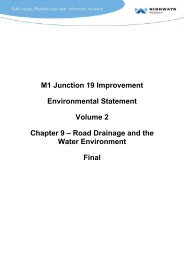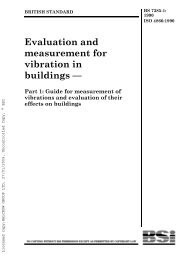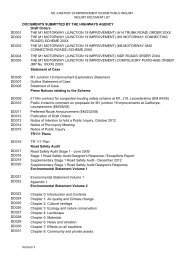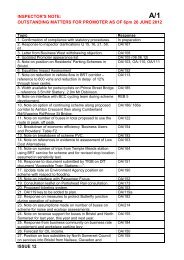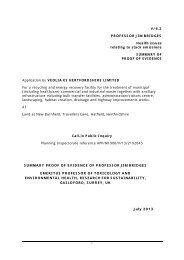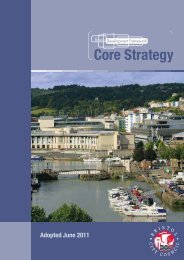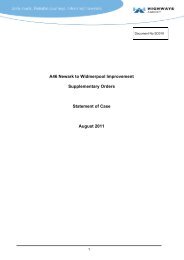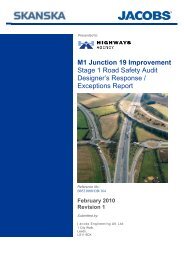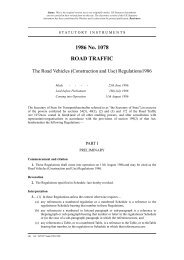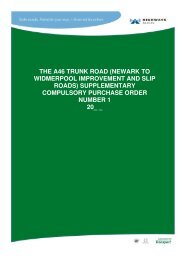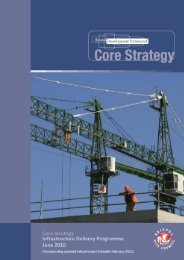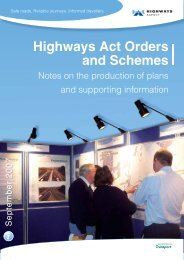Proof of Evidence of Mr James Willcock
Proof of Evidence of Mr James Willcock
Proof of Evidence of Mr James Willcock
Create successful ePaper yourself
Turn your PDF publications into a flip-book with our unique Google optimized e-Paper software.
Document Reference Number OA/13<br />
<strong>Pro<strong>of</strong></strong> <strong>of</strong> <strong>Evidence</strong> <strong>of</strong> <strong>Mr</strong> <strong>James</strong> <strong>Willcock</strong><br />
5 COMMERICAL AND PROCUREMENT ISSUES<br />
5.1 The proposed BRT service for the AVTM scheme is to replace the existing Long<br />
Ashton Park & Ride service 903, therefore the BRT service will not be an entirely<br />
new service. While the route <strong>of</strong> the AVTM BRT service will differ from service 903,<br />
the origin and destination are the same. Therefore the commercial starting point<br />
for the AVTM BRT is based on the known current passenger trips made on service<br />
903. Furthermore, service 903 is currently provided under contract to Bristol City<br />
Council (via competitive tender).<br />
5.2 The local marketplace for bus services is moderately buoyant, there are two large<br />
bus operators First and Wessex Connect, with several smaller operators providing<br />
commercial and contracted bus services in the area. There is a good degree <strong>of</strong><br />
competition for contracted bus services. In the most recent tender rounds for Park<br />
and Ride services (including the Long Ashton Park and Ride) an average <strong>of</strong> five<br />
tender bids were received. Commercial bus service competition is more limited and<br />
there is only limited route competition between bus operators for bus services<br />
along corridors between Bristol and North Somerset, except in the city centre on<br />
overlapping sections <strong>of</strong> bus routes.<br />
5.3 There are no concerns over the capacity and appetite <strong>of</strong> the marketplace to deliver<br />
the BRT services and corridor bus services. The underlying local factors and<br />
dynamics are such that there is an effective marketplace for contracted services<br />
while the extent <strong>of</strong> commercial bus service competition is more limited. Taking<br />
account <strong>of</strong> this local context in consideration <strong>of</strong> the procurement options has led us<br />
to conclude that the efficiency and effectiveness <strong>of</strong> the bus service marketplace<br />
would not be materially affected whether services are provided on a contracted or<br />
a commercial basis.<br />
5.4 The draft JPS (CD/B2) entailed a procurement options appraisal, where options<br />
were assessed and scored based upon the operational context <strong>of</strong> each BRT scheme.<br />
For the AVTM scheme, the draft JPS (CD/B2) recommends the procurement <strong>of</strong> the<br />
BRT service under contract via a competitive tender. This effectively is a<br />
continuation <strong>of</strong> the existing approach for service 903, which is contracted via<br />
competitive tender. This approach has the advantage that it manages the<br />
commercial risks to both the councils and the bus operators, very effectively. The<br />
delivery <strong>of</strong> the AVTM BRT service will require investment by the operator in a<br />
minimum <strong>of</strong> 5 vehicles for an ‘every 6 minutes’ service frequency. This represents a<br />
considerable investment in respect <strong>of</strong> capital outlay or lease arrangement in the<br />
Page 11



